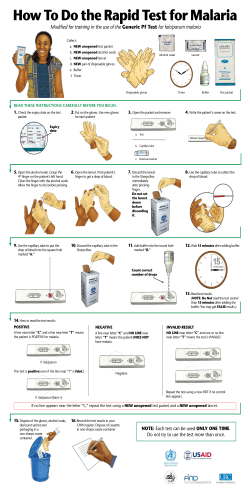
What is Capillary Ion Chromatography? Executive Summary
Monika Verma Thermo Fisher Scientific, Sunnyvale, CA, USA Executive Summary Capillary IC provides versatile benefits in the area of time, speed, sensitivity, and cost of ownership. This becomes possible with the effects of scaling down specific parameters which have successfully simplified ion chromatography. Keywords Introduction Capillary IC, continuous operate, ICS-5000+, ICS-4000 Increasing productivity has become a critical benchmarking metric as laboratories look to operate at near top efficiency within available resources. Capillary IC takes performance and ease-of-use to a whole new level, simplifying ion chromatography analyses while increasing throughput. By scaling down column size, injection volumes, and flow rates by a factor of 10 to 100, Capillary IC provides excellent eluent and waste economy, small sample requirements, and high mass sensitivity. Parameter Column I.D. Flow Rate Injection Volume Standard Bore IC Capillary IC 4 mm 0.4 mm 1.0 mL/min 10 µL/min 40 µL 0.4 µL 43.2 L/month 0.432 L/month EGC Lifetime 28 days 18 months Mass Detection Limits 7000 fg 70 fg Eluent Consumption/Waste Generated Thermo Scientific Dionex ICS-4000 (left) and ICS-5000+ (right). White Paper 7 0 5 5 2 What is Capillary Ion Chromatography? Why is Capillary IC beneficial? Costs of Ownership The waste produced is dramatically minimized which in turn reduces disposal costs. When operated as a Reagent-free Ion Chromatography™ (RFIC™) system, the Eluent Generation Cartridge lasts for 18 months under continuous operate mode. This allows maintenance costs to be nominal as the Eluent Generation Cartridge uses water as an eluent, and results in less frequent replacement of pump seals. On a unrelated but important side note, the ability to electrolytically generate the eluent results in accurate and precise eluent delivery, preventing variations typically found in manual eluent preparation. Faster Time to Results Capillary IC allows for lower flow rates by optimizing column dimensions (i.d. 0.4 mm). The typical flow rate is only 1/100th the eluent flow rate of standard bore format. Standard bore column formats typically run at flow rates of 1 mL/min. Due to the smaller cross-sectional area, the flow rate on a capillary format can be scaled down to 10 µL/min. In capillary IC, the flow rates can be increased up to 3 times, or 30 µL/min. Improved Sensitivity The combination of a first-dimension standard bore column (i.d. 4 mm) with a second-dimension capillary column (i.d. 0.4 mm) permits lower detection limits in the low ng/L range. What solutions exist on the market? The Thermo Scientific™ Dionex™ ICS-5000+ and ICS-4000 HPIC™ Systems are the world’s first capillary ion chromatography (IC) systems on the market. The Dionex ICS-5000+ operates at standard bore, microbore and capillary flow rates at pressures up to 5000 psi enabling it to also perform high-resolution and fast IC analysis with the latest 4 μm particle-size columns. On the other hand, the Dionex ICS-4000 capillary HPIC system is solely dedicated to Capillary IC. This system boasts all of the benefits of Capillary IC discussed, including high-pressure capabilities for high chromatographic resolution. Furthermore, all the Dionex ICS-5000+ and ICS-4000 systems are designed to be compatible with small particle IC columns. These columns aid in facilitating separations up to 4 times faster than conventional columns. References Dionex Homepage (http://www.dionex.com/en-us/products/ion-chromatography/ic-rfic-systems/ ics-5000/lp-72594.html) Dionex Homepage (http://www.dionex.com/en-us/products/ion-chromatography/ic-rfic-solutions/ capillary-ic/always-on-ready/lp-88647.html) Dionex Homepage (http://www.dionex.com/en-us/products/ion-chromatography/ic-rfic-solutions/ capillary-ic/columns/lp-88588.html) www.thermoscientific.com/dionex ©2013 Thermo Fisher Scientific Inc. All rights reserved. ISO is a trademark of the International Standards Organization. All other trademarks are the property of Thermo Fisher Scientific Inc. and its subsidiaries. This information is presented as an example of the capabilities of Thermo Fisher Scientific Inc. products. It is not intended to encourage use of these products in any manners that might infringe the intellectual property rights of others. Specifications, terms and pricing are subject to change. Not all products are available in all countries. Please consult your local sales representative for details. Australia +61 3 9757 4486 Austria +43 1 333 50 34 0 Belgium +32 53 73 42 41 Brazil +55 11 3731 5140 China +852 2428 3282 WP70552_E 03/13S Denmark +45 70 23 62 60 France +33 1 60 92 48 00 Germany +49 6126 991 0 India +91 22 2764 2735 Italy +39 02 51 62 1267 Japan +81 6 6885 1213 Korea +82 2 3420 8600 Netherlands +31 76 579 55 55 Singapore +65 6289 1190 Sweden +46 8 473 3380 Thermo Fisher Scientific, Sunnyvale, CA USA is ISO 9001:2008 Certified. Switzerland +41 62 205 9966 Taiwan +886 2 8751 6655 UK/Ireland +44 1442 233555 USA and Canada +847 295 7500 White Paper 7 0 5 5 2 Operating Time The benefits of capillary IC are both unique and multifaceted. In Capillary IC only 15 mL of water a day is consumed, translating into 5.2 L a year due to the low flow rates of 10 µL/min. As a result, the system can operate with continuous eluent flow, eliminating the need to wait for equilibration and allowing samples to be run at a moments notice.
© Copyright 2025







![I [Tools & Techniques]](http://cdn1.abcdocz.com/store/data/000283946_1-eed87a24a1e1770271ec5d58315043af-250x500.png)













